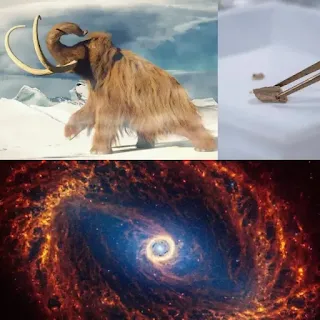Researchers from McMaster University, the University of Alaska Fairbanks, and the University of Ottawa conducted a study on a female woolly mammoth that lived 14,000 years ago. The study revealed the migration patterns that the mammoths followed, and their interactions with humans, through isotopic and genetic analysis.
Researchers documented mammoth journeys for hundreds of kilometers across northwestern Canada and Alaska. The study indicates that female mammoths lived side by side with humans for at least 1,000 years, and their movements ended when they encountered some of the first humans to cross the Beringia land bridge that connects Alaska and eastern Siberia.
The mammoth remains were discovered at Swan Point, the oldest archaeological site in Alaska, and this place likely served as a meeting point for at least two mammoths.
Sample used in the study that tracked the woolly mammoth's travels and tours of the Earth 14,000 years ago (McMaster University)
Isotopic analysis of the mammoth's tusk revealed its life history, including its final journey of more than 1,000 kilometres, and the study supports the hypothesis that ancient humans influenced mammoth populations by pursuing and hunting them.
Data indicate that ancient humans organized seasonal hunting camps based on mammoth movements, and these activities likely played an indirect role in the extinction of mammoths in Alaska.
The study sheds light on the complex behavior pattern of mammoths, direct contact with ancient humans, their social structure, and how they adapted to changing environments. The researchers stress the importance of combining isotopic and genetic analyzes to better understand the behavior of extinct mammoths and their relationship with ancient populations.
New images by James Webb astronaut of galaxies in a new look
Spiral galaxy NGC 1512, located 30 million light-years away from Earth, is seen in an undated image from the James Webb Space Telescope.
The James Webb Space Telescope revealed several detailed images of a group of spiral galaxies , including the Messier 95 galaxy "NGC 3351", which is a barred spiral galaxy. The images show a significant difference and difference from old images taken by the previous Hubble Space Telescope of the same galaxies.
The James Webb Telescope relies on near and medium infrared rays to reveal the glowing dust and gases surrounding galaxies, which appear in shades of orange and red. In contrast, the Hubble Telescope captures visible and ultraviolet light coming from the galaxy, and dark areas indicate that dust has absorbed light from stars and prevented it from reaching us.
In the arms of the galaxy away from the center, the star formation process is active, and the mid-infrared rays show part of these active processes.
The Messier 95 galaxy is located in the constellation Leo, 33 million light-years away.
Tags:
alaska
ancient
bering land bridge
eastern siberia
history
mammoth
mcmaster university
science
study reveals
university of alaska fairbanks
university of ottawa





